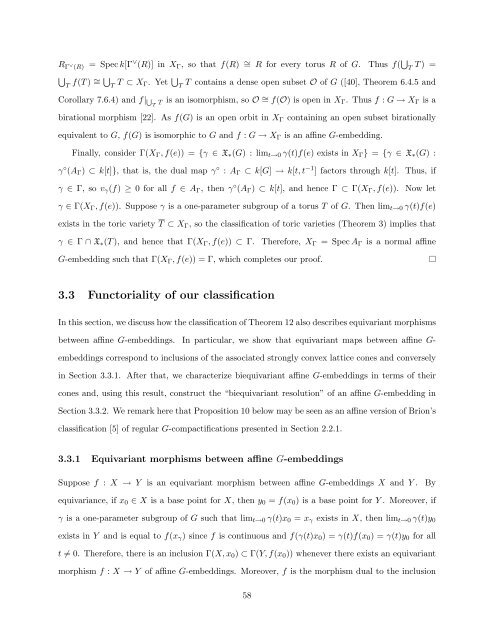Equivariant Embeddings of Algebraic Groups
Equivariant Embeddings of Algebraic Groups
Equivariant Embeddings of Algebraic Groups
You also want an ePaper? Increase the reach of your titles
YUMPU automatically turns print PDFs into web optimized ePapers that Google loves.
R Γ ∨ (R) = Spec k[Γ ∨ (R)] in X Γ , so that f(R) ∼ = R for every torus R <strong>of</strong> G. Thus f( ⋃ T T ) =<br />
⋃<br />
T f(T ) ∼ = ⋃ T T ⊂ X Γ. Yet ⋃ T<br />
T contains a dense open subset O <strong>of</strong> G ([40], Theorem 6.4.5 and<br />
Corollary 7.6.4) and f| ⋃ T T is an isomorphism, so O ∼ = f(O) is open in X Γ . Thus f : G → X Γ is a<br />
birational morphism [22]. As f(G) is an open orbit in X Γ containing an open subset birationally<br />
equivalent to G, f(G) is isomorphic to G and f : G → X Γ is an affine G-embedding.<br />
Finally, consider Γ(X Γ , f(e)) = {γ ∈ X ∗ (G) : lim t→0 γ(t)f(e) exists in X Γ } = {γ ∈ X ∗ (G) :<br />
γ ◦ (A Γ ) ⊂ k[t]}, that is, the dual map γ ◦ : A Γ ⊂ k[G] → k[t, t −1 ] factors through k[t]. Thus, if<br />
γ ∈ Γ, so v γ (f) ≥ 0 for all f ∈ A Γ , then γ ◦ (A Γ ) ⊂ k[t], and hence Γ ⊂ Γ(X Γ , f(e)). Now let<br />
γ ∈ Γ(X Γ , f(e)). Suppose γ is a one-parameter subgroup <strong>of</strong> a torus T <strong>of</strong> G. Then lim t→0 γ(t)f(e)<br />
exists in the toric variety T ⊂ X Γ , so the classification <strong>of</strong> toric varieties (Theorem 3) implies that<br />
γ ∈ Γ ∩ X ∗ (T ), and hence that Γ(X Γ , f(e)) ⊂ Γ.<br />
Therefore, X Γ = Spec A Γ is a normal affine<br />
G-embedding such that Γ(X Γ , f(e)) = Γ, which completes our pro<strong>of</strong>.<br />
3.3 Functoriality <strong>of</strong> our classification<br />
In this section, we discuss how the classification <strong>of</strong> Theorem 12 also describes equivariant morphisms<br />
between affine G-embeddings. In particular, we show that equivariant maps between affine G-<br />
embeddings correspond to inclusions <strong>of</strong> the associated strongly convex lattice cones and conversely<br />
in Section 3.3.1. After that, we characterize biequivariant affine G-embeddings in terms <strong>of</strong> their<br />
cones and, using this result, construct the “biequivariant resolution” <strong>of</strong> an affine G-embedding in<br />
Section 3.3.2. We remark here that Proposition 10 below may be seen as an affine version <strong>of</strong> Brion’s<br />
classification [5] <strong>of</strong> regular G-compactifications presented in Section 2.2.1.<br />
3.3.1 <strong>Equivariant</strong> morphisms between affine G-embeddings<br />
Suppose f : X → Y is an equivariant morphism between affine G-embeddings X and Y .<br />
By<br />
equivariance, if x 0 ∈ X is a base point for X, then y 0 = f(x 0 ) is a base point for Y . Moreover, if<br />
γ is a one-parameter subgroup <strong>of</strong> G such that lim t→0 γ(t)x 0 = x γ exists in X, then lim t→0 γ(t)y 0<br />
exists in Y and is equal to f(x γ ) since f is continuous and f(γ(t)x 0 ) = γ(t)f(x 0 ) = γ(t)y 0 for all<br />
t ≠ 0. Therefore, there is an inclusion Γ(X, x 0 ) ⊂ Γ(Y, f(x 0 )) whenever there exists an equivariant<br />
morphism f : X → Y <strong>of</strong> affine G-embeddings. Moreover, f is the morphism dual to the inclusion<br />
58
















